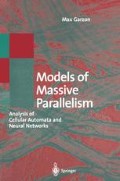Abstract
Cellular automata and discrete neural networks constitute very simple and general models that seem to capture the fundamental features of a variety of highly complex systems. Their study offers the possibility of obtaining some understanding of the most important and characteristic properties of complex and self-organizing systems, the evolution of which currently appears chaotic, disorganized and beyond the scope of known laws of nature.
ArticleNote
By indirections finds directions out.
Hamlet
Access this chapter
Tax calculation will be finalised at checkout
Purchases are for personal use only
Preview
Unable to display preview. Download preview PDF.
References
A. Akira, M. Kimura: Decomposition phenomenon in one-dimensional scope- three tesselation automata with arbitrary number of states. Inf. and Control 34 (1977) 296–313.
A. Akira, M. Kimura: Completeness in tesselation automata. Inf. and Control 35(1977) 52–86
R. Bowen: Entropy for group endomorphisms and homogeneous spaces. Trans. Amer. Math. Soc. 153 (1971) 401–414
K. Culik, S. Yu: Undecidability of CA classification schemes. Complex Systems 2 (1988) 177–190
C. Fields: Consequences of nonclassical measurement for the algorithmic description of continuous dynamical systems. J. Expt. Theor. Artif. Intell. 1 (1989) 171–178
M.R. Garey, D.S. Johnson: Computers and intractabillity: a guide to the theory of NP-completeness. W.H. Freeman, San Francisco, 1978
M. Garzon, A. Jagota: Efficient neural network isomorphism testing. In: Proc. 2nd Swedish Conference on Connectionism. Erlbaum Publishers, 1994.
M. Garzon, M. Zhang: Classifying neural networks. R.E. Trahan, Jr. (ed.). Proc. IEEE Southeast Conference, New Orleans, 1990, pp. 567–571
R. Gilman: Classes of linear automata. Ergodic Theo. and Dynam. Syst. 7 (1987) 108–118
R. Gilman: Periodic behavior of linear automata. In: Dynamical systems. Lecture Notes in Mathematics, Vol. 1342. Springer-Verlag, Berlin, 1988, pp. 216–219
E. Goles, A. Maass, S. Martinez: On the limit set of some universal cellular automata. Theoret. Comput. Sci. 110:1 (1993) 53–78
H. Gutowitz (ed.): Cellular automata: theory and applications. Proc. 3rd. Int. Conf. Cellular Automata, Los Alamos, 1991. Physica D 45 (1990).
H. Gutowitz: Mean Field vs. Wolfram Classification, preprint. CNLS, Los Alamos National Lab, NM 1988
H. Gutowitz: A hierarchical classification of cellular automata. In: [Gutl] pp. 136–158
L. Hurd: Formal language characterizations of cellular automaton limit sets. Complex Systems 1:1 (1987) 69–80
L. Hurd: The application of formal language theory to the dynamical behavior of cellular automata. Dissertation, Princeton University, 1988
L. Hurd: The nonwandering set of a CA map. Complex Systems 2:5 (1988) 549–554
L. Hurd, J. Kari, K. Culik: The topological entropy is uncomputable. Ergodic Theory and Dyn. Syst. 12:2 (1992) 255–265
M. Hurley: Attractors in cellular automata. Ergodic Theo, and Dynam. Syst. 10 (1990) 131–140
S. Ishii: Measure-theoretic approach to the classification of cellular automata. Disc. Appl. Math 39 (1992) 125–136
J. Kari, The nilpotency problem of one-dimensional cellular automata. SI AMJ. Comput. 21 (1992) 571–586
J. Kari, Rice’s Theorem for the limit sets of cellular automata. Theoret. Comput. Sci. 127:2 (1994) 229–254
P. Kürka: A comparison of finite and cellular automata. In: Math. Foundations of Computer Science MFCS, I. Privara, B. Rovan, eds. Lecture Notes in Computer Science 841, Springer-Verlag, Berlin, 1994, pp. 484–493
P. Kürka: Languages, equicontinuity and attractors in linear cellular automata. Preprint, Charles University, Praha, Czech Republic, 1994.
M. Langton: Artificial life. MIT Press, Cambridge MA, 1989.
W. Li, N. Packard: The structure of elementary cellular automata rule space. Complex Systems 4 (1990) 281–297
M. Li, P. Vitänyi: An introduction to Kolmogorov complexity and its applications. Springer-Verlag, New York, 1993
W. Li, N. Packard, C. Langton: Transition phenomena in cellular automata rule space. In: [Gutl], pp. 77–94
D. Lind, B. Marcus: An introduction to symbolic dynamics. Manuscript, 1993
J. Milnor: Directional entropies of cellular automaton maps. In: Disordered systems and biological organization, Ev. Bienenstock et al., eds. Springer- Verlag, New York, 1986, pp. 113–115
J. Milnor: On the entropy geometry of cellular automata. Complex Systems 2:3 (1988) 357–386
S. Muroga, I. Toda, S. Takasu: Theory of majority decision elements, J. Franklin Inst. 271 (1961) 376–418
I. Parberry, G. Schnitger: Parallel computation with threshold functions. J. Comput. Syst. Sci. 36 (1988) 278–302
K. Svozil: Constructive chaos by cellular automata and possible sources of an arrow of time. In: Proc. 3rd Int. Conf. in Cellular Automata, 1989. Physica D 45 (1990) 420–427
K. Sutner: A note on Culik-Yu classes. Ccpmplex Systems 3 (1989) 107–115
S. Wolfram: Twenty problems in the theory of cellular automata. Physica Scripta T9 (1985) 170–183
S. Wolfram: Statistical mechanics of cellular automata. Rev. of Modern Phys. 55:3 (1983) 601–644
S. Wolfram: Random sequence generation by cellular automata. Adv. in Applied Math. 7 (1986) 123–169. Reprinted in [Wo4]
S. Wolfram: Theory and Applications of cellular automata. World Scientific Publishing, Singapore, 1986.
Author information
Authors and Affiliations
Rights and permissions
Copyright information
© 1995 Springer-Verlag Berlin Heidelberg
About this chapter
Cite this chapter
Garzon, M. (1995). Classification. In: Models of Massive Parallelism. Texts in Theoretical Computer Science. An EATCS Series. Springer, Berlin, Heidelberg. https://doi.org/10.1007/978-3-642-77905-3_8
Download citation
DOI: https://doi.org/10.1007/978-3-642-77905-3_8
Publisher Name: Springer, Berlin, Heidelberg
Print ISBN: 978-3-642-77907-7
Online ISBN: 978-3-642-77905-3
eBook Packages: Springer Book Archive

